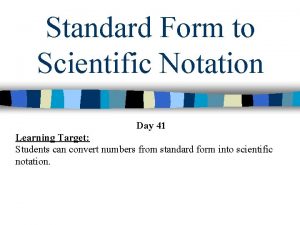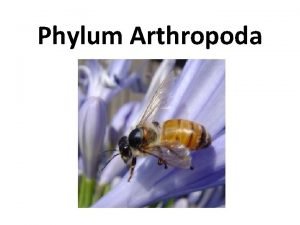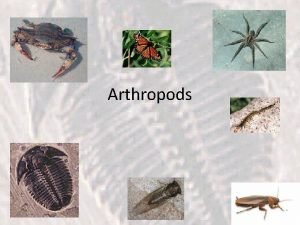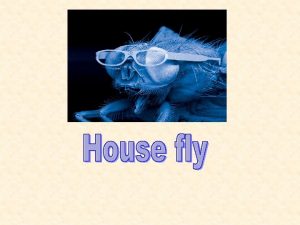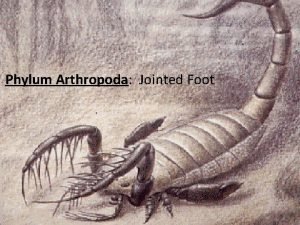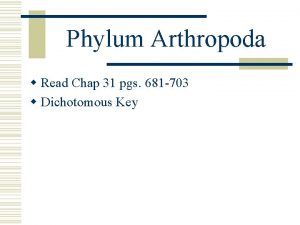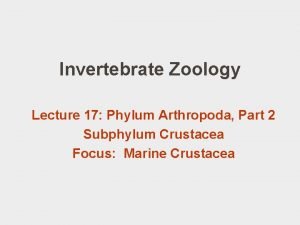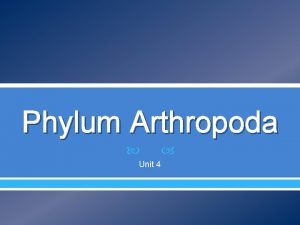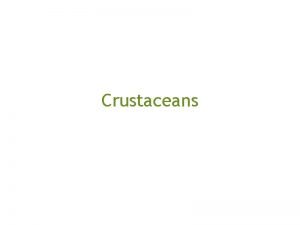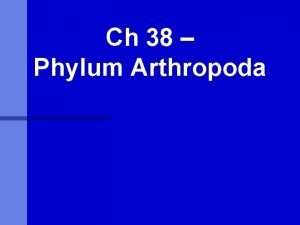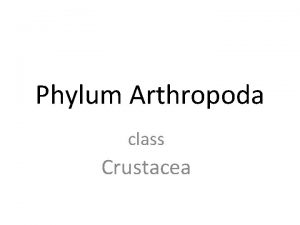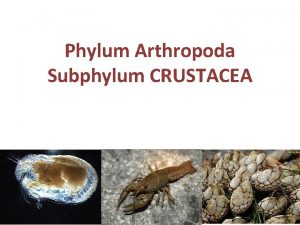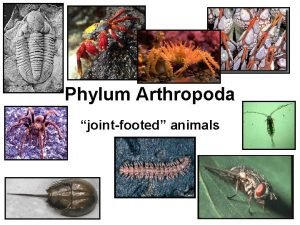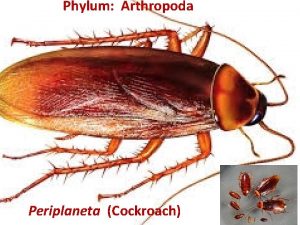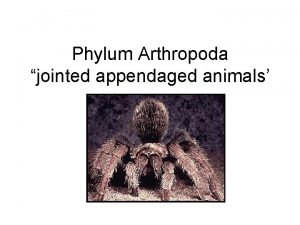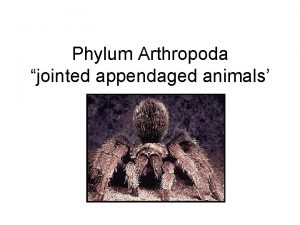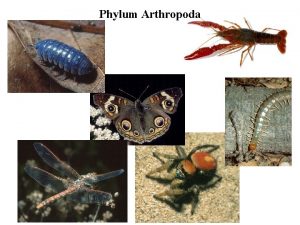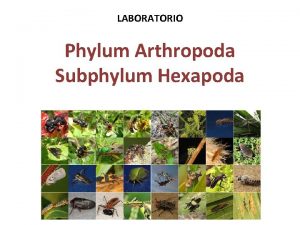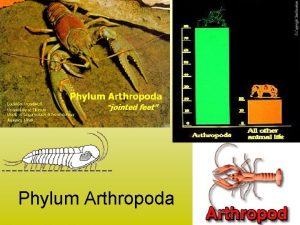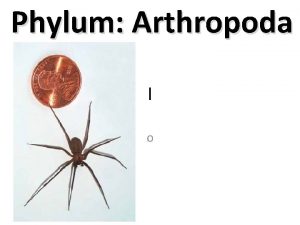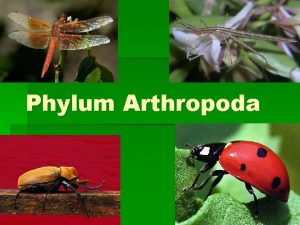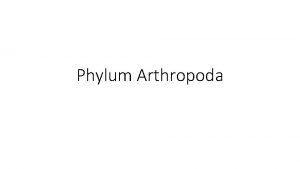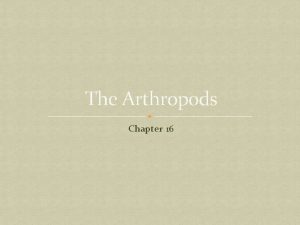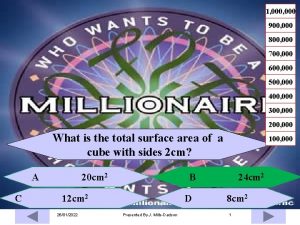Phylum Arthropoda Largest phylum of animals 900 000























- Slides: 23

Phylum Arthropoda

• • Largest phylum of animals. >900, 000 species 78% of all animals are arthropods “Most successful animal group” • Arthropod = “jointed foot (appendages)” • Probable evolution from the annelids (elongated, segmented bodies)

• -Well developed organ systems • -One pair of jointed appendages per segment • -Segments are fused …. Head/thorax/abdomen • -Open circulatory system (blood rarely in vessels)

• Dorsal heart • -Ventral nervous system • -Distinct head, often with compound eyes • -Many have wings

Classification Domain: Kingdom: Phylum: Eukarya Animalia Arthropoda 4 Subphyla • 1) Trilobita : extinct sea dwellers • 2) Chelicerata : “Arachnids” • 3) Crustacea : Crabs/lobsters/shrimp • 4) Uniramia : Centipedes, millipedes, insects

Trilobite

• Through evolution, segmentation has decreased! • 3 “BIG” Arthropod Characteristics – Jointed Appendages – Segmented bodies – Exoskeleton

Exoskeleton • Advantages: Protection, support, prevents water loss, anchor for muscle tissue • Disadvantages: Non-living (don’t grow). Must molt. Leaves them vulnerable to predators. Can be heavy – limits mobility. • Exoskeleton is actually a set of hinged plates.


• Molting: Very energy consuming. Leaves them vulnerable to predators • Appendage types: walking legs, wings, antennae, claws, flippers, mouthparts • Feeding strategies: Herbivores, Carnivores, Parasites, Filter feeders, detritus feeders. • Mouthpart types: Chewing, sucking, soaking (spongey), and lapping.

• Respiration: Gills, book lungs, tracheal tubes • Gills: Feathery, found under exoskeleton. Mouthpart and appendage movement keeps a steady flow of water over the gills. Aquatic Arthropods only – Crustaceans. • Book lungs: Sheets of tissue increase surface area for gas exchange. Sac-like structure attached to a spiracle (opening). • Tracheal tubes: From spiracles, these long, branching tubes extend deep into animal’s tissue. Air is “pumped” through tracheal tubes.



Internal Transport : Dorsal heart. Open circulatory system. Blood collects in empty chambers called sinuses. Defense Mechanisms • Claws • Exoskeleton • Flight • Running • Venomous stingers or bites • Chemical release • Deception/mimicry • Camouflage






Movement: powerful muscles attached to legs, wings, flippers Reproduction: Sexual, internal fertilization. Growth & Development: Molting controlled by hormones. Takes hours/days. Vulnerability.

Metamorphosis: “Dramatic change in form. ” Controlled by hormones. Incomplete metamorphosis: Eggs Nymph Adult. Series of molts required. Complete metamorphosis: Egg Larvae Pupae Adult


 97 000 in scientific notation
97 000 in scientific notation 602 200 000 000 000 000 000 000 in scientific notation
602 200 000 000 000 000 000 000 in scientific notation 71 000 in scientific notation
71 000 in scientific notation Largest animal phylum
Largest animal phylum 090-0000-0000
090-0000-0000 Arthropoda common name
Arthropoda common name Section 36-1 review phylum arthropoda
Section 36-1 review phylum arthropoda Kingdom: animalia phylum: arthropoda class: insecta
Kingdom: animalia phylum: arthropoda class: insecta Odonata wings
Odonata wings Introduction of phylum arthropoda
Introduction of phylum arthropoda Dichotomous key
Dichotomous key Jointed foot phylum
Jointed foot phylum What is tagmatization
What is tagmatization Phylum arthropoda
Phylum arthropoda Arthropods respiratory system
Arthropods respiratory system Kingdom animalia phylum arthropoda
Kingdom animalia phylum arthropoda Subphylum uniramia
Subphylum uniramia Crustacean phylum
Crustacean phylum Sub-phylum
Sub-phylum Classes in phylum arthropoda
Classes in phylum arthropoda 33 900 000 in scientific notation
33 900 000 in scientific notation Activity based costing formula
Activity based costing formula Annelids
Annelids Https://a-z-animals.com/
Https://a-z-animals.com/
